Dr Vino's wine blog
wine talk that goes down easy
Chilean earthquake: wineries, tanks, bottles damaged or destroyed
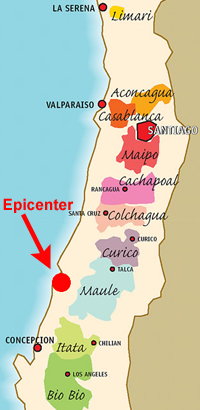 Tragedy struck Chile overnight on Friday in the form of a massive earthquake that has displaced two million people, severed north-south bridges in the narrow country, and killed hundreds of people (see coverage on nytimes.com).
Tragedy struck Chile overnight on Friday in the form of a massive earthquake that has displaced two million people, severed north-south bridges in the narrow country, and killed hundreds of people (see coverage on nytimes.com).
Chile has a large, export-oriented wine industry. Some of infrastructure, particularly in the regions of Maule and Rapel (including Colchagua), has been damaged or destroyed. Contacted via email, Lori Tieszen, executive director of Wines of Chile USA, says that Jose Manuel Ortega reports “devastation” in Maule and that his winery sustained some damage; Julio Bouchon of J. Bouchon, “is safe but his beautiful old winery is leveled,” Tieszen writes. In 2006, the Oxford Companion to Wine described Maule as “slowly changing its reputation of growing only bulk wine.”
“One can smell wine along the roads in front of the wineries. Tanks laying, collapsed buildings, barrels and glass everywhere,” winemaker Sven Bruchfeld told James Molesworth, wine critic for Chilean wine at Wine Spectator magazine.
Molesworth has been tweeting what he hears from wineries (follow his feed for the latest). Another source told him, “Big damage to the industry. Millions of liters on the floor.” He also tweeted that Montes and Lapostolle were hit hard in Colchagua, an area that had seen lots of investment in the wine indsutry. Feel free to add news in the comments if you have updates.
Depending on the region and grape variety, the harvest has already started or was scheduled to start soon in the country.
From the annals of wine marketing…enzymes!
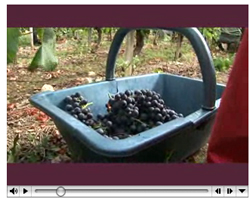 We’re all snow-bound here in the northeast today. So rather than shoveling, kick back and check out the latest video from the annals of wine marketing! This one is from enzymes producer Novozymes and was sent in by site reader Damien.
We’re all snow-bound here in the northeast today. So rather than shoveling, kick back and check out the latest video from the annals of wine marketing! This one is from enzymes producer Novozymes and was sent in by site reader Damien.
Here’s the video’s pitch on why winemakers should use enzymes:
Major wineries produce large quantities of wine and as a result need to optimize their capacity by reducing production times. [image: hand harvesting] Enzymes are used by these larger wineries to speed up production process. Small wineries on the other hand are more interested in using enzymes to produce a higher quality of wine, particularly when the grape quality isn’t the best.
Other quotage comes form their enthusiastic client, Ch. Tour Prignac, who says that they use it “to produce optimum quality and obtain a color fitting to a great, age-worthy wine.”
They later elaborate that their products, under the VinoFlo name, offer deep colors and flavor intensity.
Chile, upmarket, downmarket, SF, yellow cards – sipped and spit
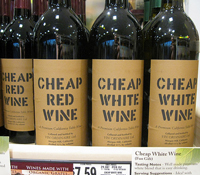 SPIT: a move upmarket
SPIT: a move upmarket
The Chilean wine industry attempted a concerted move upmarket a few years ago. But the strong peso and weak global economy have crushed those plans. To wit: exports were up a whopping 17.6% by volume last year but flat by value. [LA Times]
SPIT: California bargains
Mike Steinberger contemplates the puzzle of why so few “superstar” winemakers in California make wines under $20. We discussed the lack of tasty California values last year in relation to Fred Franzia, and heard from wine importer Bobby Kacher and winemaker Patrick Campbell.
SPIT: urban winemaking
Crushpad, the pioneer urban winery in San Francisco, has announced it will move its operations to Napa where its main supplier has space. Of note: two-thirds of their clients are commercial wine brands. [NYT]
SIPPED: innovation
While New York is debating selling wine in grocery stores (and foods in wine stores), Pennsylvania, where the state still owns all the wine stores, gets wine bars in supermarkets! Groc-o-pubs anyone? [Philly.com]
SIPPED: footy!
Unruly winery visitors in the Finger Lakes will get yellow and red cards. [WENY]
SPIT: truth
A shocking piece on Slate.com reveals that during Prohibition, federal officials “ordered the poisoning of industrial alcohols manufactured in the United States, products regularly stolen by bootleggers and resold as drinkable spirits. The idea was to scare people into giving up illicit drinking.” But instead it accounted for 10,000 fatalities. Unmentioned in the brief story, but maybe people were on to the scheme and that helped account for the rise in home winemaking during Prohibition?
Astor Wines says no to Styro, yes to plastic sleeves
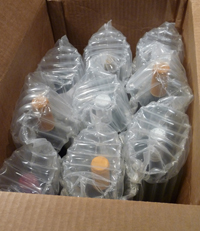 I got a few wines from Astor Wine & Spirits in Greenwich Village via UPS the other day. When I opened the box, there was no Styrofoam. There weren’t any cardboard inserts. Instead, each bottle was wrapped in an inflatable plastic sleeve. It was the first time I’d seen this.
I got a few wines from Astor Wine & Spirits in Greenwich Village via UPS the other day. When I opened the box, there was no Styrofoam. There weren’t any cardboard inserts. Instead, each bottle was wrapped in an inflatable plastic sleeve. It was the first time I’d seen this.
Styrofoam is popular with retailers and wineries shipping wine because it cradles and insulates the bottles. While it is ultralight, thereby reducing the carbon footprint of the shipment, it essentially never biodegrades. I always try to bring my Styro shippers back to a store so that they can be used again before their life taking up space in a landfill. One store, Grapes the Wine Company, actually includes a pre-paid label so consumers can return the empty box back to the store via Fedex for reuse and a store credit. Corrugated cardboard inserts are recyclable but they are quite heavy, increasing the carbon footprint. Pulp inserts are light and biodegradable.
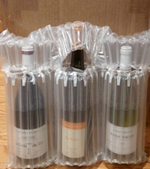 The plastic sleeves that Astor uses, branded as Air-Paq, are both light and recyclable (though they are resin code 7, which many municipalities don’t recycle). Their staff inserts the bottles in the sleeve, then use a gizmo to inject the air and seal the sleeve (you can see a scintillating demo video here).
The plastic sleeves that Astor uses, branded as Air-Paq, are both light and recyclable (though they are resin code 7, which many municipalities don’t recycle). Their staff inserts the bottles in the sleeve, then use a gizmo to inject the air and seal the sleeve (you can see a scintillating demo video here).
Reached via email, Andrew Fisher, owner of Astor, pointed out that it is much more space-efficient in their shipping area than Styrofoam, since there is just a plastic roll and a compressor. He elaborated, “Since Astor produces its own electricity and recaptures the waste heat to provide heating and cooling for our space, it seemed both incongruous and inconsistent to cling to Styrofoam shipping materials.”
Each bottle rests in an independent sleeve from the others so it can also be separated and used again for your wine travel needs. Or, if you have two boys like us, they each can put them on a hand and have a sword fight!
Related: “Poll: Styrofoam or cardboard for your wine shipping?“
BREAKING: Korean feast not impossible with wine!
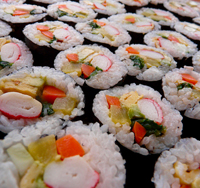 Not intimidated by the Herculean challenge of pairing wine and Korean food, I selected a range of wines for a Korean new year feast last week.
Not intimidated by the Herculean challenge of pairing wine and Korean food, I selected a range of wines for a Korean new year feast last week.
The “impossibility” of the pairing centers on two things: 1) kimchi and spices and 2) a culture clash that came up in our previous discussion about whether wine (and alcohol) should be seen as a complement to the food or as a “palate cleanser,” a role that the high-octane soju often performs at Korean feasts.
Playing sommelier for the evening, I selected a range of wines Read more…
Korean feast: impossible food-wine pairing?!?
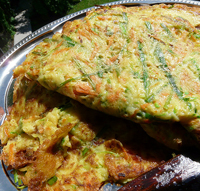 Tomorrow night I will be selecting the wine pairings for a Korean feast, getting in on the lunar new year action a few days late. Here’s a list of some items on the menu, from the hostess:
Tomorrow night I will be selecting the wine pairings for a Korean feast, getting in on the lunar new year action a few days late. Here’s a list of some items on the menu, from the hostess:
Fried dumplings
Chicken yakitori [japanese inspiration]
Beef skewers (do you know bulgoki?)
Squid/spicy sauce
A variety of “jun” (pictured, right) which is something like potato pancakes but with fish, beef, vegetables, or seafood
California roll or ”kimbap” which is rolled “maki” with veggies/beef
Side vegetables – pickled, salad-like
Apparently it is impossible to pair Korean food with wine! And I’m not just saying that. Consider this comment from sommelier-to-the-max, Rajat Parr (from What to Drink with What you Eat): “I love Korean food, but it’s hard to have any kind of wine with it unless you have a Vinho Verde or something that’s really high in acid…the acidity in kimchee just kills wine and it’s all over.”
What do you think: do you buy the high acidity suggestion? Or do you prefer something aromatic and off-dry? How about bubbles? Or something slightly oxidative? Do reds work? Or is pairing Korean food with wine impossible!?!
Related: “Kimchi: impossible food-wine pairing?“
Just heard: Jay McInerney will be the WSJ wine columnist…
 Jay McInerney, author of Bright Lights, Big City among other works of fiction, has been named WSJ wine columnist according to a tweet from Ray Isle, wine editor of Food & Wine magazine.
Jay McInerney, author of Bright Lights, Big City among other works of fiction, has been named WSJ wine columnist according to a tweet from Ray Isle, wine editor of Food & Wine magazine.
McInerney wrote a monthly wine column at House & Garden until Condé Nast shuttered the magazine in 2007. His columns were compiled in two books, Bacchus & Me (amazon, aff) and The Hedonist in the Cellar (amazon, aff). So here’s one wine writer who was able to find a job again!
In 2006, he married Anne Hearst. With that kind of financial fusion, perhaps he will buy his own wine instead of the Journal picking up the tab?
McInerney will replace John Brecher and Dorothy Gaiter who ended twelve years as wine columnists in December. Their popular column had a populist slant, periodically reviewing white zinfandel, wine on cruise ships, at Disney World and their annual, participatory “open that bottle night.” By contrast, McInerney, whose punchy column ended before the recession took hold, frequently wrote about fine and collectible wines.
Pinot evil: French court finds 12 guilty in Gallo faux pinot
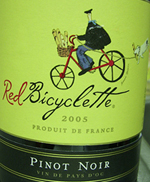 A French court found 12 executives guilty of selling the equivalent of 18 million bottles of cheaper wine as pinot noir. The buyer was California’s E&J Gallo for their Red Bicyclette brand, which sells for about $9 a bottle.
A French court found 12 executives guilty of selling the equivalent of 18 million bottles of cheaper wine as pinot noir. The buyer was California’s E&J Gallo for their Red Bicyclette brand, which sells for about $9 a bottle.
AFP reports that generic red wines fetched 45 euros (about $62) per one hundred liters while the premium pinot noir fetched 97 euros. One of the firms involved had been paying 58 euros for the wines it sold to Gallo. The accused made seven million euros ($9.5 million) in the scheme.
The defendants, from two firms, received suspended jail sentences and fines between 3,000 and 45,000 euros. Reuters reports that one firm, Sieur D’Arques, had to pay a fine of 180,000 euros.
Gallo issued a statement saying that they were “deeply disappointed” to learn of the fraud at one of their suppliers. The statement continued: “We believe that the only French Pinot Noir that was potentially misrepresented to us would have been the 2006 vintage and prior.” They also added that there was no health risk and that they would be withdrawing the wine from the market.
On the Red Bicyclette website, they tout the pinot noir as “world acclaimed” and point out that the 2006 vintage received a score of 83 points from Wine Spectator and the 2005 received various medals at wine competitions, including a bronze San Francisco International Wine Competition and a silver at both the Taster’s Guild International Wine Competition and Finger Lakes International Wine Competition.
“If Americans lose confidence in French wine production, particularly the Languedoc region, which is already going through a serious crisis, the consequences could be terrible,” Francis Battut, the prosecutor, told AFP.
A lawyer for one defendant told AFP “Not a single American consumer complained.” Another defense lawyer said that the wine had delivered “Pinot Noir characteristics.” On Marketplace Morning Report this morning, a commentator said that consumers don’t even know what pinot noir tastes like.
But it hardly seems like consumers’ fault. Does $9 pinot really taste like pinot noir? It’s worth noting that federal regulations allow blending of up to 25 percent other varieties into a wine labeled by its grape variety.
What does this faux pinot ruling mean for you? What with counterfeits on the high end and Brunello blending, rule-breaking and fraud seem to be making the rounds in the wine world.




